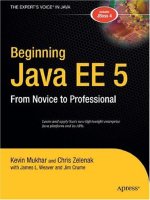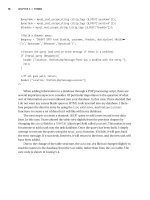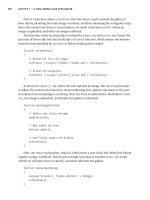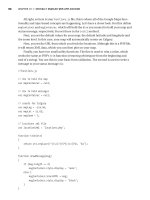Beginning Java EE 5 From Novice to Professional phần 1 doc
Bạn đang xem bản rút gọn của tài liệu. Xem và tải ngay bản đầy đủ của tài liệu tại đây (514.25 KB, 10 trang )
Beginning Java EE 5
From Novice to Professional
■■■
Kevin Mukhar and Chris Zelenak
with James L. Weaver and Jim Crume
Mukhar_470-3Front.fm Page i Tuesday, October 4, 2005 6:20 AM
Beginning Java EE 5: From Novice to Professional
Copyright © 2006 by Kevin Mukhar and Chris Zelenak, with James L. Weaver and Jim Crume
All rights reserved. No part of this work may be reproduced or transmitted in any form or by any means,
electronic or mechanical, including photocopying, recording, or by any information storage or retrieval
system, without the prior written permission of the copyright owner and the publisher.
ISBN (pbk): 1-59059-470-3
Printed and bound in the United States of America 9 8 7 6 5 4 3 2 1
Trademarked names may appear in this book. Rather than use a trademark symbol with every occurrence
of a trademarked name, we use the names only in an editorial fashion and to the benefit of the trademark
owner, with no intention of infringement of the trademark.
Lead Editor: Steve Anglin
Technical Reviewer: Dilip Thomas
Editorial Board: Steve Anglin, Dan Appleman, Ewan Buckingham, Gary Cornell, Tony Davis, Jason Gilmore,
Jonathan Hassell, Chris Mills, Dominic Shakeshaft, Jim Sumser
Project Manager: Sofia Marchant
Copy Edit Manager: Nicole LeClerc
Copy Editors: Marilyn Smith, Ami Knox, Nicole LeClerc
Assistant Production Director: Kari Brooks-Copony
Production Editor: Laura Cheu
Compositor: Susan Glinert Stevens
Proofreader: Elizabeth Berry
Indexer: Broccoli Information Management
Artist: Kinetic Publishing Services, LLC
Cover Designer: Kurt Krames
Manufacturing Director: Tom Debolski
Distributed to the book trade worldwide by Springer-Verlag New York, Inc., 233 Spring Street, 6th Floor,
New York, NY 10013. Phone 1-800-SPRINGER, fax 201-348-4505, e-mail , or
visit .
For information on translations, please contact Apress directly at 2560 Ninth Street, Suite 219, Berkeley, CA
94710. Phone 510-549-5930, fax 510-549-5939, e-mail , or visit .
The information in this book is distributed on an “as is” basis, without warranty. Although every precaution
has been taken in the preparation of this work, neither the author(s) nor Apress shall have any liability to
any person or entity with respect to any loss or damage caused or alleged to be caused directly or indirectly
by the information contained in this work.
The source code for this book is available to readers at in the Source Code section.
Mukhar_470-3Front.fm Page ii Tuesday, October 4, 2005 6:20 AM
1
■ ■ ■
CHAPTER 1
Java EE Essentials
The word enterprise has magical powers in computer programming circles. It can increase the
price of a product by an order of magnitude and double the potential salary of an experienced
consultant. Your application may be free of bugs, and cleanly coded using all the latest tech-
niques and tools, but is it enterprise-ready? What exactly is the magic ingredient that makes
enterprise development qualitatively different from run-of-the-mill development?
Enterprise applications solve business problems. This usually involves the safe storage,
retrieval, and manipulation of business data: customer invoices, mortgage applications, flight
bookings, and so on. They might have multiple user interfaces: a web interface for consumers
and a graphical user interface (GUI) application running on computers in the branch offices,
for example. Enterprise applications must deal with communication between remote systems,
coordinate data in multiple stores, and ensure the system always follows the rules laid down by
the business. If any part of the system crashes, the business loses part of its ability to function
and starts to lose money. If the business grows, the application needs to grow with it. All this
adds up to what characterizes enterprise applications: robustness in the face of complexity.
When we set out to build a GUI application, we don’t start by working out how to draw
pixels on the screen and build our own code to track the user’s mouse around the screen; we
rely on a GUI library, like Swing, to do that for us. Similarly, when we set out to create the
components of a full-scale enterprise solution, we would be crazy to start from scratch.
Enterprise programmers build their applications on top of systems called application
servers. Just as GUI toolkits provide services of use to GUI applications, application servers
provide services of use to enterprise applications—things like communication facilities to talk
to other computers, management of database connections, the ability to serve web pages, and
management of transactions.
Just as Java provides a uniform way to program GUI applications on any underlying oper-
ating system, Java also provides a uniform way to program enterprise applications on any
underlying application server. The set of libraries developed by Sun Microsystems and the Java
Community Process that represent this uniform application server application programming
interface (API) is what we call the Java Platform, Enterprise Edition 5 (Java EE 5), and it is the
subject of this book.
This chapter provides a high-level introduction to Java EE. In this chapter, you will learn:
• Why you would want to use Java EE
• What the benefits of a multitier application architecture are
• How Java EE provides vendor independence and scalability
Mukhar_470-3.book Page 1 Saturday, October 1, 2005 6:14 AM
2
CHAPTER 1
■ JAVA EE ESSENTIALS
• What the main Java EE features and concepts are
• How to use common Java EE architectures
So, without further ado, let’s get started!
What Is Java EE?
Since you’re reading this book, you obviously have some interest in Java EE, and you probably
have some notion of what you’re getting into. For many fledgling Java EE developers, Java EE
equates to Enterprise JavaBeans (EJBs). However, Java EE is a great deal more than just EJBs.
While perhaps an oversimplification, Java EE is a suite of specifications for APIs, a distributed
computing architecture, and definitions for packaging of distributable components for deploy-
ment. It’s a collection of standardized components, containers, and services for creating and
deploying distributed applications within a well-defined distributed computing architecture.
Sun’s Java web site says, “ Java Platform, Enterprise Edition 5 (Java EE 5) defines the standard
for developing component-based multitier enterprise applications.”
As its name implies, Java EE is targeted at large-scale business systems. Software that functions
at this level doesn’t run on a single PC—it requires significantly more computing power and
throughput than that. For this reason, the software needs to be partitioned into functional
pieces and deployed on the appropriate hardware platforms. That is the essence of distributed
computing. Java EE provides a collection of standardized components that facilitate software
deployment, standard interfaces that define how the various software modules interconnect,
and standard services that define how the different software modules communicate.
How Java EE Relates to J2SE
Java EE isn’t a replacement for the Java 2 Standard Edition (J2SE). J2SE provides the essential
language framework on which Java EE builds. It is the core on which Java EE is based. As you’ll
see, Java EE consists of several layers, and J2SE is right at the base of that pyramid for each compo-
nent of Java EE.
As a Java developer, you’ve probably already learned how to build user interfaces with the
Swing or Abstract Window Toolkit (AWT) components. You’ll still be using those to build the
user interfaces for your Java EE applications, as well as HTML-based user interfaces. Since J2SE
is at the core of Java EE, everything that you’ve learned so far remains useful and relevant.
In addition, Java EE provides another API for creating user interfaces. This API is named
JavaServer Faces (JSF) and is one of the newest Java EE technologies. You’ll also see that the
Java EE platform provides the most significant benefit in developing the middle-tier portion of
your application—that’s the business logic and the connections to back-end data sources.
You’ll use familiar J2SE components and APIs in conjunction with the Java EE components and
APIs to build that part of your applications.
Why Java EE?
Java EE defines a number of services that, to someone developing enterprise-class applications,
are as essential as electricity and running water. Life is simple when you simply turn the faucet
and water starts running, or flip the switch and lights come on. If you have ever been involved
with building a house, you know that there is a great deal of effort, time, and expense in building
Mukhar_470-3.book Page 2 Saturday, October 1, 2005 6:14 AM
CHAPTER 1 ■ JAVA EE ESSENTIALS
3
the infrastructure of plumbing and wiring, which is then so nicely hidden behind freshly painted
walls. At the points where that infrastructure is exposed, there are standard interfaces for
controlling (water faucets and light switches, for example) and connecting (power sockets,
lamp sockets, and hose bibs, for example) to the infrastructure.
Suppose, though, that the wiring and plumbing in your home wasn’t already there. You
would need to put in your own plumbing and electricity. Without standard components and
interfaces, you would need to fabricate your own pipes, wiring, and so on. It would be terrifically
expensive and an awful lot of work.
Similarly, there is a great deal of infrastructure required to write enterprise-class applica-
tions. There are a bunch of different system-level capabilities that you need in order to write
distributed applications that are scalable, robust, secure, and maintainable. Some vital pieces
of that infrastructure include security, database access, and transaction control. Security ensures
that users are who they claim to be and can access only the parts of the application that they’re
entitled to access. Database access is also a fundamental component so that your application
can store and retrieve data. Transaction support is required to make sure that the right data is
updated at the right time. If you’re not familiar with some of these concepts, don’t worry—
you’ll be introduced to them one at a time throughout this book.
Putting in a distributed computing infrastructure—the plumbing and wiring of an archi-
tecture that supports enterprise applications—is no simple feat. That’s why Java EE-based
architectures are so compelling; the hard system-level infrastructure is already in place.
But why not custom build (or pay someone to custom build) an infrastructure that is
designed around your particular application? Well, for starters, it would take a fantastic amount
of time, money, and effort. And even if you were to build up that infrastructure, it would be
different from anyone else’s infrastructure, so you wouldn’t be able to share components or
interoperate with anyone else’s distributed computing model. That’s a lot of work for some-
thing that sounds like a dead end. And if you were lucky enough to find a vendor that could sell
you a software infrastructure, you would need to worry about being locked into that single
vendor’s implementation, and not being able to switch vendors at some point in the future.
The good news is, no surprise, that Java EE defines a set of containers, connectors, and
components that fill that gap. Java EE not only fills the gap, but it’s based on well-known,
published specifications. That means that applications written for Java EE will run on any
number of Java EE-compliant implementations. The reference implementation supplied with
the Java EE Software Development Kit from Sun (Java EE SDK) provides a working model that
we’ll use throughout this book, since it’s the implementation that Sun has built from the specifi-
cation and is freely available. In the next chapter, you’ll get an introduction to installing and
testing the Java EE SDK.
Multitier Architecture
One of the recurring themes that you’ll run into with Java EE is the notion of supporting
applications that are partitioned into several levels, or tiers. That is an architectural cornerstone
of Java EE and merits a little explanation. If you are already familiar with n-tier application
architectures, feel free to skip ahead. Otherwise, the overview presented here will be a good
introduction or review that will help lay the foundation for understanding the rationale behind
much of Java EE’s design and the services it provides.
If you think about a software application composition, you can break it down into three
fundamental concerns, or logical layers:
Mukhar_470-3.book Page 3 Saturday, October 1, 2005 6:14 AM
4
CHAPTER 1
■ JAVA EE ESSENTIALS
• The first area of concern is displaying stuff to the user and collecting data from the user.
That user interface layer is often called the presentation layer, since its job is to present
stuff to the user and provide a means for the user to present stuff to the software system.
The presentation layer includes the part of the software that creates and controls the
user interface and validates the user’s actions.
• Underlying the presentation layer is the logic that makes the application work and
handles the important processing. The process in a payroll application to multiply the
hours worked by the salary to determine how much to pay someone is one example of
this kind of logic. This logical layer is called the business rules layer, or more informally
the middle tier.
• All nontrivial business applications need to read and store data, and the part of the soft-
ware that is responsible for reading and writing data—from whatever source that might
be—forms the data access layer.
Single-Tier Systems
Simple software applications are written to run on a single computer, as illustrated in Figure 1-1.
All of the services provided by the application—the user interface, the persistent data access,
and the logic that processes the data input by the user and reads from storage—all exist on the
same physical machine and are often lumped together into the application. That monolithic
architecture is called single tier, because all of the logical application services—the presentation,
the business rules, and the data access layers—exist in a single computing layer.
Single-tier systems are relatively easy to manage, and data consistency is simple because
data is stored in only one single location. However, they also have some disadvantages. Single-
tier systems do not scale to handle multiple users, and they do not provide an easy means of
sharing data across an enterprise. Think of the word processor on your personal computer:
It does an excellent job of helping you to create documents, but the application can be used by
only a single person. Also, while you can share documents with other people, only one person
can work on the document at a time.
Figure 1-1. In the traditional computer application, all of the functionality of the application
exists on the user’s computer.
Mukhar_470-3.book Page 4 Saturday, October 1, 2005 6:14 AM
CHAPTER 1 ■ JAVA EE ESSENTIALS
5
Client/Server (Two-Tier) Architecture
More significant applications may take advantage of a database server and access persistent
data by sending SQL commands to a database server to save and retrieve data. In this case, the
database runs as a separate process from the application, or even on a different machine than
the machine that runs the rest of the program. As illustrated in Figure 1-2, the components for
data access are segregated from the rest of the application logic. The rationale for this approach is
to centralize data to allow multiple users to simultaneously work with a common database,
and to provide the ability for a central database server to share some of the load associated with
running the application. This architecture is usually referred to as client/server and includes
any architecture where a client communicates with a server, whether that server provides data
access or some other service.
Figure 1-2. In a client/server architecture, an application client accesses services from another
process to do its job.
It’s convenient and more meaningful to conceptualize the division of the responsibility
into layers, or tiers. Figure 1-3 shows the client/server software architecture in two tiers.
Mukhar_470-3.book Page 5 Saturday, October 1, 2005 6:14 AM
6
CHAPTER 1
■ JAVA EE ESSENTIALS
Figure 1-3. The client/server architecture shown in a layer, or tier, diagram
One of the disadvantages of two-tier architecture is that the logic that manipulates the
data and applies specific application rules concerning the data is lumped into the application
itself. This poses a problem when multiple applications use a shared database. Consider, for
example, a database that contains customer information that is used for order fulfillment,
invoicing, promotions, and general customer resource management. Each one of those appli-
cations would need to be built with all of the logic and rules to manipulate and access customer
data. For example, there might be a standard policy within a company that any customer
whose account is more than 90 days overdue will be subject to a credit hold. It seems simple
enough to build that rule into every application that’s accessing customer data, but when the
policy changes to reflect a credit hold at 60 days, updating each application becomes a real
mess.
You might be tempted to try to solve this problem by building a reusable library that
encapsulates the business rules. When the rules change, you can just replace that library,
rebuild the application, and redistribute it to the computers running the application. There are
some fundamental problems with that strategy, however. First, that strategy assumes that all of
the applications have been created using the same programming language, run on the same
platform, or at least have some strategy for gluing the library to the application. Next, the appli-
cations may need to be recompiled or reassembled with the new library. Moreover, even if the
library is a drop-in replacement without requiring recompiling, it’s still going to be a royal pain
to make sure that each installation of the application has the right library installed simultaneously
(it wouldn’t do to have conflicting business rules being enforced by different applications at
the same time).
In order to get out of that mess, the logical thing to do is to physically separate those busi-
ness rules out from the computers running the applications onto a separate server so that the
software that runs the business rules needs to be updated only once, not for each computer
that runs the application.
N-Tier Architecture
Figure 1-4 shows a third tier added to the two-tier client/server model. In this model, all of the
business logic is extracted out of the application running at the desktop. The application at the
desktop is responsible for presenting the user interface to the end user and for communicating
to the business logic tier. It is no longer responsible for enforcing business rules or accessing
databases. Its job is solely as the presentation layer.
Mukhar_470-3.book Page 6 Saturday, October 1, 2005 6:14 AM
CHAPTER 1 ■ JAVA EE ESSENTIALS
7
■Note Bear in mind that at this point we’re talking somewhat abstractly and theoretically. In a perfect
world, without performance and other implications, the division of responsibility in an application would be
very clear-cut. You’ll see throughout this book that you must make practical, balanced implementation decisions
about how responsibilities are partitioned in order to create an application that is flexible and performs well.
Figure 1-4. A common enterprise architecture consists of three tiers: presentation, business,
and data.
Typically, in a deployed application, the business logic tier executes on a server apart from
the workstation (you’ll see shortly that this isn’t absolutely required, though). The business
logic tier provides the logical glue to bind the presentation to the database. Since it’s running
on a server, it’s accessible to any number of users on the network running applications that
take advantage of its business rules. As the number of users demanding those services increases,
and the business logic becomes increasingly complex and processor-intensive, the server can
be scaled up or more servers can be added. Scaling a single server is a lot easier and cheaper
than upgrading everyone’s workstations.
One of the really great things that this architecture makes possible is the ability to start to
build application models where the classes defined in the business logic tier are taken directly
from the application domain. The code in the business logic layer can work with classes that
model things in the real world (like a Customers class) rather than working with complex SQL
statements. By pushing implementation details into the appropriate layer, and designing
applications that work with classes modeled from the real world, applications become much
easier to understand and extend.
It’s possible to continue the process of partitioning the application functionality into
increasingly thin functional layers, as illustrated in Figure 1-5. There are some very effective
application architectures based on n-tier architecture. The application architect is free to
partition the application into as many layers as appropriate, based on the capabilities of the
computing and network hardware on which the system is deployed. However, you do need to
be careful about reaching a point of diminishing returns, since the performance penalty for the
network communication between the layers can start to outweigh any gains in performance.
Mukhar_470-3.book Page 7 Saturday, October 1, 2005 6:14 AM
8
CHAPTER 1
■ JAVA EE ESSENTIALS
Figure 1-5. An enterprise application is not limited to two or three tiers. The software architect can
design the system to consist of any number of layers, depending on the system requirements and
deployment configuration.
In summary, n-tier application architecture is intended to address a number of problems,
including the following:
• The high cost of maintenance when business rules change. N-tier applications have
improved maintainability.
• Inconsistent business rule implementation between applications. N-tier applications
provide consistency.
• Inability to share data or business rules between applications. N-tier applications offer
interoperability.
• Inability to provide web-based front ends to line-of-business applications. N-tier appli-
cations are flexible.
• Poor performance and inability to scale applications to meet increased user load. N-tier
applications are scalable.
• Inadequate or inconsistent security across applications. N-tier applications can be
designed to be secure.
The Java EE architecture is based on the notion of n-tier applications. Java EE makes it very
easy to build industrial-strength applications based on two, three, or more application layers,
and provides all of the plumbing and wiring to make that possible.
Mukhar_470-3.book Page 8 Saturday, October 1, 2005 6:14 AM









